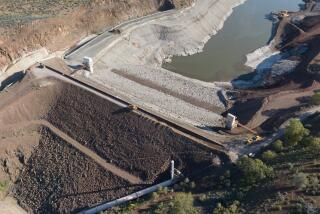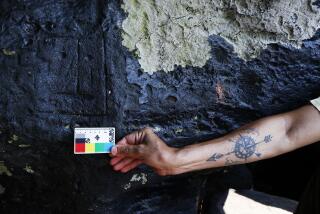COLUMN ONE : Portugal Between Rock Art, Hard Place : New dam would help the young democracy meet its needs. But it may mean drowning a trove of Ice Age engravings on the river valley’s walls.
- Share via
LISBON — Conflict between the needs of 21st-Century Portuguese and the unique testimony of their Ice Age ancestors is starkly written on the rock walls of a desolate river valley.
Hundreds of newly discovered rock engravings hewn 20,000 years ago in what may prove to be the world’s largest outdoor gallery of prehistoric art are facing death by drowning in the valley of the Coa River in northern Portugal.
The engravings of animals, including horses, wild goats and aurochen, the Paleolithic ancestors of cattle, were inscribed on outcroppings along both sides of the valley by nomadic hunter-gatherers toward the end of the last Ice Age.
They have come to light belatedly, after environmental-impact research for a nearby $330-million dam under construction by the state electric company. The project will drown the valley under 300 feet of water once the dam is complete in about four years.
Scrap the dam to save hard-to-get-to, hard-to-see engravings? Flood the art to give Portugal more electricity and greater control of its water supplies?
Portugal, wed to development and sprinting to catch up with mainstream Europe after half a century of backwardness and dictatorship, is not used to grappling publicly with such thorny questions.
But for the first time in this young democracy, the inevitable confrontation between tomorrow’s needs and yesterday’s legacies is provoking soul-searching national debate over rival claims on the environment and the economy.
“Under dictatorship, things were destroyed and people didn’t care,” political analyst Alvaro Vasconcelos said. “An ancient Roman encampment swept away for an airport, an 800-year-old Romanesque church gutted at the caprice of an ambitious parish priest. But times are changing.”
What is being tested is precisely whether, in changing times, it is possible for grass-roots pressure to save the art in the face of expensive technology.
“I think they will build the dam, because I am not accustomed to seeing people who have power in this country abdicate it for these kinds of reasons,” said Jose Luis Ramos Pinheiro, news director at the country’s biggest radio station. “Ten years ago, we would never have heard about the engravings. In another 10 years, maybe it would be possible to stop the dam.”
First official word of the engravings came in a one-line mention to a government agency in a 1993 report from an archeologist commissioned at agency behest and power company expense to conduct a required survey of the valley.
The archeologist, now under heavy criticism, is accused of planning to keep his findings secret until he was able to publish them.
Neither did the government agency called IPPAR, which is charged with protecting Portugal’s archeological and architectural heritage, show much enthusiasm to publicize or evaluate the finds.
Critics now charge a cover-up. IPPAR, or Portuguese Institute for Architectural and Archeological Patrimony, and the electric company deny that.
Designed to create a backup reservoir to regulate water levels at five other dams on the nearby Douro River, the Coa dam is being built by Electricidade de Portugal, the giant, government-owned utility.
The Portuguese, who call it EDP, are used to seeing the company have its way.
*
Critics charge EDP is a state within the state. They say the extent and value of the prehistoric valley art could have been known before construction began--and might have become crucial to the decision whether to build at all--if EDP and government regulators at IPPAR had done their homework better.
“Don’t forget, we paid for the research. Without EDP, it might have been another 20,000 years before the art was seen,” company spokesman Antonio Ribeiro dos Santos said.
“It was a pleasant surprise for us to find material of world value. Only in the past few weeks have we become aware of how valuable it is. Now we must reconcile national interest and cultural interest. National heritage will not be put into danger because of EDP,” he said.
The first findings were in a 600-foot stretch along one side of the valley. Many animals are chiseled shapes. Others are represented in outline forged in the softer rock in a foreboding region of the Iberian interior, where until recently scientists doubted there had been Paleolithic, or early Stone Age, settlement.
The engravings are the witness of a Cro-Magnon people of whom there is as yet no other trace.
Does the art signify a bellies-full celebration by successful hunters? A religious appeal for food? A deer-up-the-valley sort of signpost? Or simply a decorative reproduction of nature by a primitive people? Some are quite moving: a pair of ancient horses nuzzling, for example. In dull light on weathered rock, others are hard to make out.
There are no roads into the area, and few people live nearby. Access is by boat or old sheep trails, but since reports of the engravings surfaced, professional and amateur prospectors have discovered a series of engravings on discontinuous outcroppings along more than 10 miles of valley side. One important find was made by a Portuguese emigrant to Canada who was home on vacation.
“The number of engravings is growing every week,” said Joao Zilhao, a University of Lisbon professor of prehistoric archeology. “We now have at least 200 large hammered ones. For each of them, there may be 30 or 40 finely incised figures that are hard to see.
“I think we are talking about the largest and oldest open-air Paleolithic site in the world.”
*
Zilhao is leading academic attempts to stop the dam. “To find 15 kilometers of valley art is a shock. It will force people to change the way they look at Paleolithic man and art,” he said.
There are other outdoor sites in Portugal and neighboring Spain, but most Paleolithic art is known from drawings in about 300 caves in southwestern Europe. A spectacular new find was reported last month near Avignon, France.
An irony not lost on the poorer Portuguese is that the rich French need only to put a door on the new Chauvet Cave to protect its treasures: Tourists need not apply.
By contrast, if the Coa Valley art is saved from drowning, it then must be protected from thieves and vandals and displayed in some compelling way for visitors; expensive undertakings.
“It is difficult to look at the engravings without thinking of cave paintings. Likely the whole valley was a vast sanctuary,” said Jose Morais Arnaud, president of the Assn. of Portuguese Archeologists. “At the start, when we had one group of engravings, I thought, ‘It’s too late to save the engravings, just let’s study what’s left.’ Now the situation is completely different. There are hundreds on both sides, plus those drowned already (by waters from the next dam upstream). The deeper the research, the greater the problem.”
Arnaud said that, after some initial differences of opinion over the merits of the engravings, there is unanimity among Portugal’s 200 archeologists that the new-found engravings must not be drowned.
The electric company stoutly defends the new dam, planned to hold 450 million cubic meters of water.
“It is important for the 150,000 homes to which it will supply electricity, but also for its strategic value, reducing reliance on Spain and as a cog in an eventual network to distribute water from the north to the drier south,” EDP’s dos Santos said.
Academic and political critics, though, insist that there is no compelling economic or social need for the dam.
“None of the dams built in the next valley over the past 30 years has stopped economic decay and population decline in the area,” Zilhao said.
*
In the flux, construction by a Portuguese-Spanish-French consortium begun last September continues apace less than a mile from the nearest group of engravings.
“The situation is not very promising. The electric company is working 24 hours a day,” Arnaud said.
The oversight agency IPPAR, which has authority to halt the construction, has not done so.
“Construction work does not collide directly with the task of preserving the engravings,” agency president Nuno Santos Pinheiro said in an interview.
United Nations specialists have examined the site at Portugal’s invitation.
One of them, Jean Clottes, a prehistoric art expert who advises the French Culture Ministry, originally wondered aloud if geologists might decide that the engravings could endure without damage under water, in effect locked away for study by future generations after the dam’s 70- to 100-year lifetime.
Such a choice would suit the dam’s defenders, but Clottes has, on reflection, changed his mind, he said by telephone from France.
“I saw one site of about 60 animals some time ago. If the engravings are as widespread as it now seems, there must be archeological sites associated with them. The area must be fully studied,” Clottes said.
IPPAR’s Santos Pinheiro said that, once final reports of a second U.N. mission are in later this month, they will be relayed to the Culture Ministry, which has ultimate authority over archeological sites.
With conservationists vigorously rallying international support and finding a strong echo in the Portuguese media, it seems only a question of time until the dispute moves on to the national political agenda.
Fernando Lima, spokesman for center-right Prime Minister Anibal Cavaco Silva, said the government will not interfere.
“I think there will be a consensus decision,” he said in an interview.
*
Still, there is an emerging left-right flavor to the debate.
Commercial interests in the region, such as the dam’s builders and local people in the conservative rural area, tend not to be impressed by the engravings.
But 15,000 high school students, led by their teachers, staged anti-dam street protests in northern towns recently.
President Mario Soares, a canny old Socialist who is his country’s most consummate politician, visited the engravings for the first time--and came away visibly impressed.
“Our party’s official position is that work must be stopped,” said Socialist leader Antonio Guterres at his party’s headquarters.
Current polls foresee Guterres becoming Portugal’s next prime minister after national elections this year.
After 20,000 years, their future may yet prove a watery grave, but the prehistoric art has at least a fighting chance today in a country shaking off the last remnants of dictatorship.
“There is more public debate in Portugal today than ever. The press is freer, opinions are more strongly expressed,” analyst Vasconcelos said. “A changed mentality gives underdogs the ability to fight--even if they lose.”
Montalbano was recently on assignment in Lisbon.
More to Read
Sign up for Essential California
The most important California stories and recommendations in your inbox every morning.
You may occasionally receive promotional content from the Los Angeles Times.













